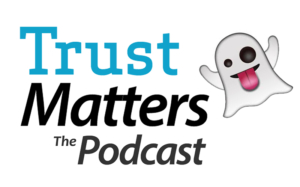 In a recent TrustMatters webinar, I shared four key attributes of Trusted Advisor relationships, and six mindsets that can help you get there.
In a recent TrustMatters webinar, I shared four key attributes of Trusted Advisor relationships, and six mindsets that can help you get there.
You can view this and all our free webinar recordings here. For those of you who prefer to read versus watching a recording, here’s what we discussed.
Four Attributes of Trusted Advisor Relationships
True Trusted Advisors are safe havens for tough issues – those people to whom we can turn for any challenge, professional or private, when we want guidance, support, or a sounding board. The special professional relationships Trusted Advisors form have four key attributes that distinguish them. These attributes are:
Personal. We often define our professional relationships by the roles we play: client and consultant, business partner and provider, customer and customer success advisor. Thinking about our relationships in terms of our roles creates a buffer and promotes the concept that we are working together only to fulfill a transaction. For trusted advisors, the relationship transcends the transaction. It is not a relationship between roles, but a relationship between two people. To be a Trusted Advisor, we must care about our client as a person.
Two-way. No one has the power to unilaterally create a Trusted Advisor relationship. The client must participate and reciprocate. While we can always strive to be more trustworthy, we won’t – can’t – be Trusted Advisors to all our clients. That isn’t to say you shouldn’t invest in building trust with all your clients, just that if it isn’t two-way, it’s limited.
Both Rational and Emotional. Trusted Advisor relationships go beyond the rational benefits, like solving business problems and meeting business needs, to engage on an emotional level. Empathy, the ability to recognize what someone is experiencing emotionally, is a critical element to connecting. But Trusted Advisorship also is more than deep friendship. Don’t overlook that being a Trusted Advisor means being comfortable engaging on a broad set of issues, not just those for which we’ve been hired.
Intrinsically about Perceived Risk. To quote from The Trusted Advisor, “Trust without risk is like cola without fizz; there isn’t much point to it.” The very act of trusting is taking a risk; if there were no risk, there would be no need for trust. Risk, real and perceived, varies based on the situation, but the client’s perception of their own risk may as well be the reality. Whether or not we agree with that perception, we need to acknowledge and respond in kind.
Mindset Matters
So how do we develop relationships that have these key attributes? It’s simplistic to look for tips and tricks without considering the importance of Trusted Advisor mindsets. And often, having the right mindset will help us naturally take the right action. Mindset hacks are simple things we can do to get – and stay – in the right mindset.
Here are six key Trusted Advisor mindsets, and a hack to get into each one.
Mindset #1: Focus on the other person. If we focus on the other person, everything else in the relationship will pretty much fall into place. As professionals, it would seem obvious that we would be focused on the other person. But there are a lot of impediments to other-focus. For example, we may believe that our technical capability or competency is enough, or have difficulty maintaining concentrated attention, or we’re focused on what they think about us. Maybe it’s just that we think that solving the problem is more important than understanding the problem. All of these are impediments to other focus.
The mindset hack here is to focus on the person, not the problem. Clients generally want to be understood as a precondition to having their problems solved.
Mindset #2: Self-confidence. Self-confidence is about recognizing the value that you bring to the relationship, beyond technical expertise or the results of a particular transaction. The biggest impediment to self-confidence is fear; that we’re wrong, that they won’t think we’re smart or competent, or like or respect us. So we push conversations to our expertise, to where we’re comfortable. With self-confidence, you can let the conversation go where it naturally will, knowing you can meet the client where they are.
The mindset hack for self-confidence is to ask yourself, “What value do I bring to the relationship?” (Beyond the technical expertise to solve the challenge is that’s in front of you.)
Mindset #3: Ego strength. This sounds like a strange one for trusted advisors, where we spend so much time talking about maintaining a low self orientation. Ego strength is the ability to take yourself out of the equation and focus on the process of developing the relationship. Ego strength requires objectivity, the ability to look past ourselves and our emotions and focus on the process of building the relationship. Impediments to ego strength include a desire for recognition or an avoidance of blame; inappropriate emotional attachment to our solution, idea or perspective; and losing sight of the big picture. We let what we want to get emotionally out of a situation get in the way of the relationship.
The mindset hack for ego strength is a mantra, “It’s not about me.” If you feel yourself thinking about getting the credit, or the blame, or you find you’re tied up in something that’s emotional for you, just remind yourself that it’s not about you.
Mindset #4: Curiosity. The mindset around curiosity is this: the problem is rarely as simple as it seems at first pass. David Maister, co-author of The Trusted Advisor, points out that the problem is never what the client says it is in the first meeting. Curiosity helps us focus on what we don’t know, not just on what we do know. It enables better solutions, ensures we’re solving the right problem, and demonstrates to client that we fully understand them. Some things that get in the way of curiosity are over-confidence from past experience (you’ve seen this before and know the answer), unexplored or unrecognized assumptions, and urgency. Don’t get so caught up solving the problem that you forget to understand the problem.
The mindset hack for curiosity is one question: “What’s behind that?” It’s non-judgmental and creates an opportunity for the other person to share more before we move on to the next step in problem solving.
Mindset #5: Inclusive professionalism. This is not “inclusive” in the sense of DEI. Inclusive professionalism means working with the client, not carrying the attitude that, as the professional, I’m here to fix them or do something they are not capable of doing. Inclusive professionalism requires that we embrace the value the client contributes to do our job correctly. Some inhibitors to inclusive professionalism include fear of losing control, patronization stemming from ego, and the assumption that they offer limited value because they asked for our help. Lack of transparency can also be exclusive. Our clients are specialists and experts in their roles. We may have a different perspective or experience, but they are experts at what they do, and we need both parts, together, to succeed.
The mindset hack for inclusive professionalism is a simple statement: “We will be more successful together.” That suggests they have something to add and we have something to add, and only together can we be successful.
Mindset #6: The relationship is the goal. It’s easy to get so caught up in work we’re doing that we forget about the relationship. Relationships survive bad events. Not projects. And relationships lead to growth, not deliverables. One impediment to a relationship mindset is short term thinking. If you only focus on this project or transaction, you give up the future potential the relationship holds. Similarly, only focusing on the technical problem leaves you with nothing when the problem is solved. Another major impediment is a lack of willingness to invest emotionally, to care about our clients as human beings.
The mindset hack is very, very simple. “The relationship is more important than …” The relationship is more important than not being blamed, than defending myself, than completing this deliverable right now. If we always put the relationship first, then our behaviors will follow.
Keeping Yourself on Track
Changing your mindset takes practice and intentionality. These four questions will help you be intentional about your mindset:
- Who am I thinking about?
- What does the client feel about this?
- Who am I serving by my present approach?
- What am I afraid of here?
The next time you feel yourself slipping out of the Trusted Advisor mindsets, ask yourself these four questions to get back on track.
Content for this post sourced from The Trusted Advisor by Maister, Green, and Galford, The Free Press, 2000; and Trust-Based Selling by Charles H. Green, McGraw Hill, 2006.
Trust-Based Resources to Maximize Your Team’s Potential:
 How do you build trust in your team or organization?
How do you build trust in your team or organization?
 There are many misconceptions about trust that pervade how we think about professional relationships. While most seem harmless (think about Ronald Reagan’s admonition to trust, but verify), unless they are examined and dispelled, they will impede real trust.
There are many misconceptions about trust that pervade how we think about professional relationships. While most seem harmless (think about Ronald Reagan’s admonition to trust, but verify), unless they are examined and dispelled, they will impede real trust. In a recent TrustMatters webinar, I shared four key attributes of Trusted Advisor relationships, and six mindsets that can help you get there.
In a recent TrustMatters webinar, I shared four key attributes of Trusted Advisor relationships, and six mindsets that can help you get there. Zoom and other virtual meeting spaces helped save personal and professional relationships across the globe during the COVID-19 pandemic. While we all adjusted to an explosion in the prevalence of virtual teams, which have since revolutionized the modern workplace, the challenges were — and still are, quite honestly — clear.
Zoom and other virtual meeting spaces helped save personal and professional relationships across the globe during the COVID-19 pandemic. While we all adjusted to an explosion in the prevalence of virtual teams, which have since revolutionized the modern workplace, the challenges were — and still are, quite honestly — clear. There are seemingly endless reasons our clients do not take our advice. Challenges like internal disagreements, budget constraints, and rotating decision-makers can cause countless proposals to be refused or ignored, regardless of how obvious the need may appear.
There are seemingly endless reasons our clients do not take our advice. Challenges like internal disagreements, budget constraints, and rotating decision-makers can cause countless proposals to be refused or ignored, regardless of how obvious the need may appear.
